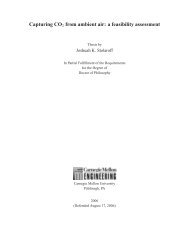Royal Society - David Keith
Royal Society - David Keith
Royal Society - David Keith
You also want an ePaper? Increase the reach of your titles
YUMPU automatically turns print PDFs into web optimized ePapers that Google loves.
climate and environmental effects and social<br />
consequences (both intended and unintended) before<br />
they should be considered for large-scale experiments<br />
or deployment.<br />
Of the Solar Radiation Management methods considered,<br />
stratospheric aerosols are currently the most promising<br />
because their effects would be more uniformly distributed<br />
than for localised Solar Radiation Management methods,<br />
they could be much more readily implemented than<br />
space-based methods, and would take effect rapidly<br />
(within a year or two of deployment). However, potentially<br />
significant uncertainties and risks are associated with<br />
this approach and research into methods of delivery<br />
and deployment, effectiveness, impacts on stratospheric<br />
ozone and high-altitude tropospheric clouds, and detailed<br />
modelling of their impacts on all aspects of climate<br />
(including precipitation patterns and monsoons) is needed.<br />
It would be risky to embark on the implementation of any<br />
large-scale Solar Radiation Management methods, which<br />
may not be sustainable in the long term, and which would<br />
do nothing for the ocean acidification problem, without a<br />
clear and credible exit strategy.<br />
Key recommendations:<br />
• Geoengineering methods of both types should only be<br />
considered as part of a wider package of options for<br />
addressing climate change. Carbon Dioxide Removal<br />
methods should be regarded as preferable to Solar<br />
Radiation Management methods as a way to augment<br />
continuing mitigation action in the long term. However<br />
Solar Radiation Management methods may provide a<br />
potentially useful short-term backup to mitigation in<br />
case rapid reductions in global temperatures are<br />
needed;<br />
• Carbon Dioxide Removal methods that have been<br />
demonstrated to be safe, effective, sustainable and<br />
affordable should be deployed alongside conventional<br />
mitigation methods as soon as they can be made<br />
available;<br />
• Solar Radiation Management methods should not be<br />
applied unless there is a need to rapidly limit or reduce<br />
global average temperatures. Because of the<br />
uncertainties over side-effects and sustainability they<br />
should only be applied for a limited time period, and if<br />
accompanied by aggressive programmes of<br />
conventional mitigation and/or Carbon Dioxide<br />
Removal so that their use may be discontinued in due<br />
course.<br />
Future needs for geoengineering<br />
If geoengineering is to have a future role, and is to be<br />
applied responsibly and effectively, then coordinated and<br />
collaborative work is needed to enhance knowledge,<br />
develop governance mechanisms and agree decisionmaking<br />
processes.<br />
Key recommendation:<br />
• To ensure that geoengineering methods can be<br />
adequately evaluated, and applied responsibly and<br />
effectively should the need arise, three priority<br />
programmes of work are recommended:<br />
a. internationally coordinated research and<br />
technological development on the more<br />
promising methods identified in this report;<br />
b. international collaborative activities to further<br />
explore and evaluate the feasibility, benefits,<br />
environmental impacts, risks and opportunities<br />
presented by geoengineering, and the associated<br />
governance issues;<br />
c. the development and implementation of<br />
governance frameworks to guide both research<br />
and development in the short term, and possible<br />
deployment in the longer term, including the<br />
initiation of stakeholder engagement and a public<br />
dialogue process.<br />
Governance<br />
The international mechanisms most applicable to<br />
geoengineering methods and their impacts have not been<br />
developed for the purpose of regulating geoengineering,<br />
and for some methods there are as yet no regulatory<br />
mechanisms in place.<br />
The greatest challenges to the successful deployment<br />
of geoengineering may be the social, ethical, legal and<br />
political issues associated with governance, rather than<br />
scientific and technical issues. For some methods, like<br />
ambient air capture, pre-existing national mechanisms<br />
are likely to be sufficient, for others, such as ocean ironfertilisation,<br />
existing international mechanisms may be<br />
relevant but require some modification. There will however<br />
be some methods, particularly those that require<br />
transboundary activity or which have transboundary<br />
effects, for example stratospheric aerosols or space-based<br />
mirrors, which may require new international mechanisms.<br />
Appropriate governance mechanisms for deployment<br />
should be established before Carbon Dioxide Removal<br />
or Solar Radiation Management methods are actually<br />
needed in practice. This will require an analysis of whether<br />
existing international, regional and national mechanisms<br />
are appropriate for managing geoengineering, and the<br />
initiation of an international dialogue involving the<br />
scientific, policy, commercial and non-governmental<br />
communities.<br />
It would be highly undesirable for geoengineering methods<br />
that involve activities or effects (other than simply the<br />
removal of greenhouse gases from the atmosphere)<br />
that extend beyond national boundaries to be subject<br />
to large-scale research or deployment before appropriate<br />
governance mechanisms are in place. It is essential that<br />
the governance challenges posed by geoengineering<br />
are explored, and policy processes established as<br />
a priority.<br />
The <strong>Royal</strong> <strong>Society</strong><br />
Geoengineering the Climate I September 2009 I xi








